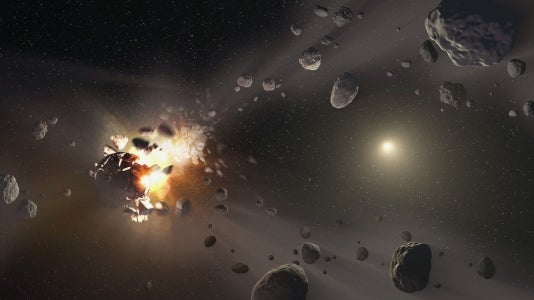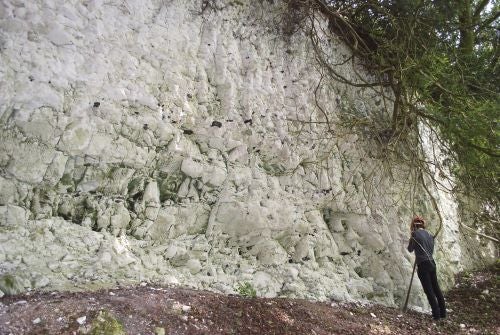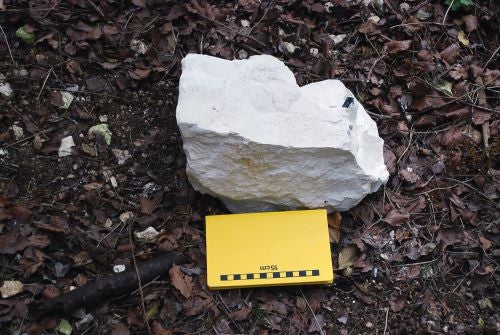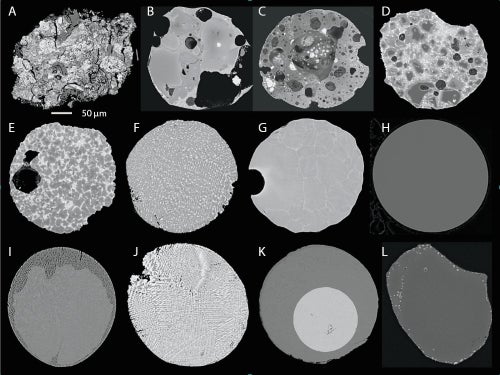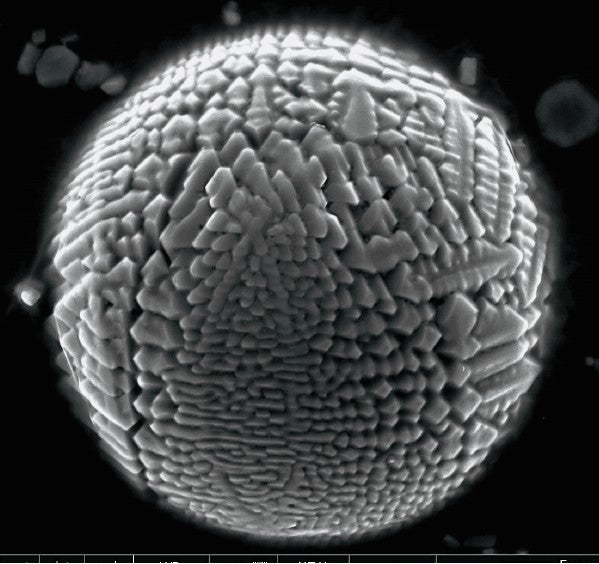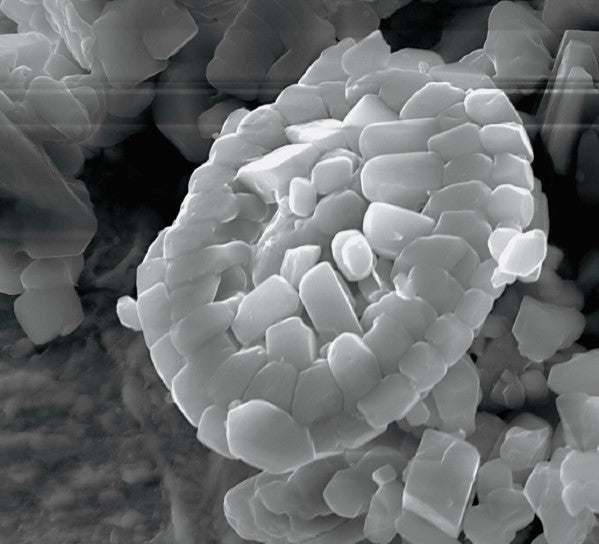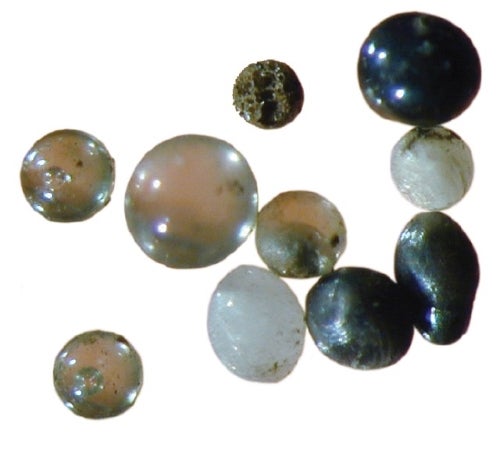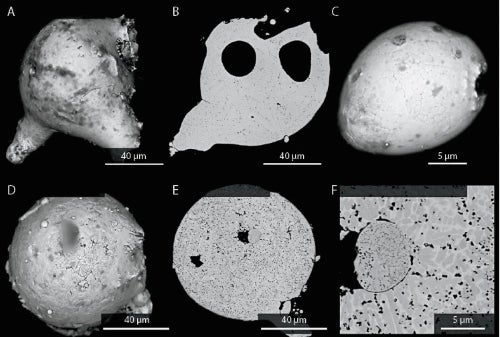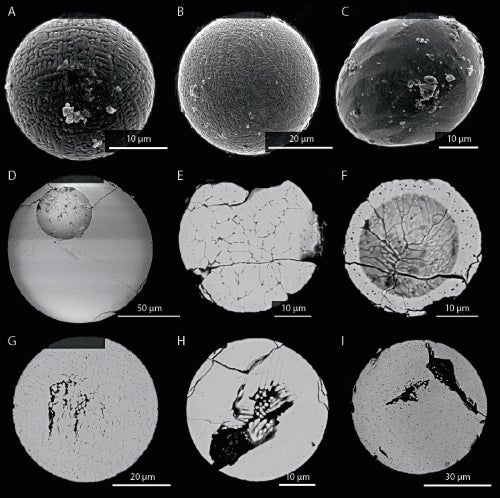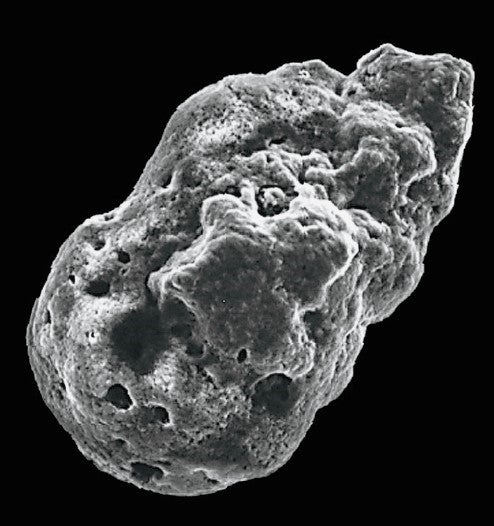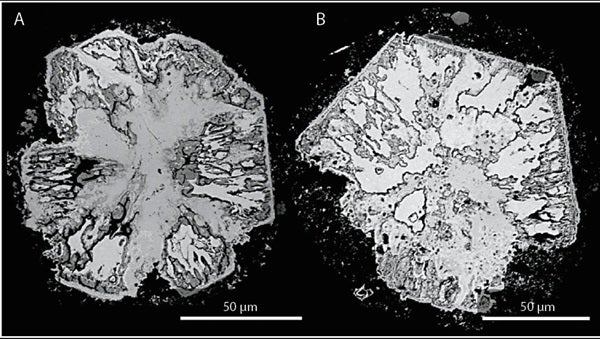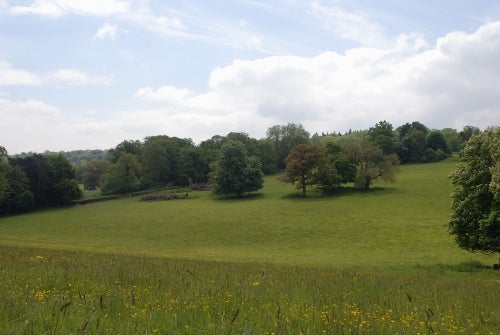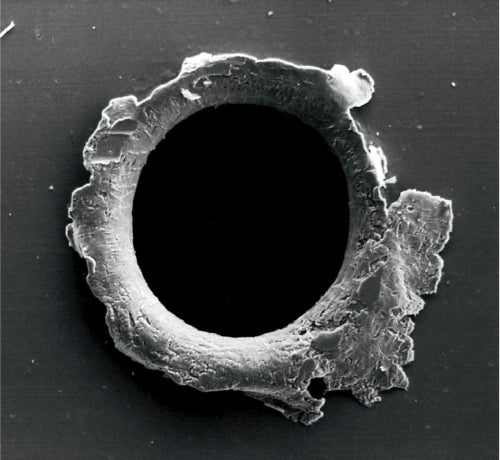The Ph.D. student at Imperial College London had collected 76 tiny grains of space dust that had fallen to Earth near the white chalk hills of the North Downs, close to his home in Kent, England. When Suttle used a microscope to study the sand-sized particles — found in a layer of 87-million-year-old rock — he recognized the characteristic shape of small round spherules, like metal droplets. But when he cut them open and looked inside, he was surprised by what he saw.
Where Suttle expected to find nickel, a common metal in meteorites, he instead found manganese, an element more associated with the geological processes of Earth’s deep-sea floor. He scanned more particles with the same results. Suttle left the microscope disheartened. The samples looked like space dust, but the geochemistry was wrong.
“I was kind of disappointed,” says Suttle, who is now a planetary scientist and geologist at the Natural History Museum in London. “I thought, ‘Oh, these aren’t micrometeorites. These are something else.”
Then, Suttle and his adviser, Imperial College planetary geologist Matthew Genge, took another look. This time, they noticed that the minerology was more familiar than it had seemed at first glance. The relative ratios were right. But the manganese was where the nickel was supposed to be.
The pair also found that, while the grains looked like micrometeorites, they contained tiny flaws. They had small growths and protrusions — something often seen in fossils when the minerals replacing organic material aren’t an exact 1-to-1 match. Suttle and Genge began to form a hypothesis: Perhaps the spherules were simply fossilized micrometeorites.
Cosmic time capsules
“It was a gradual realization,” Suttle says. “It was entirely plausible that these particles, when they were embedded in the seafloor mud, had been altered through diagenesis,” the chemical process that converts sediment into sedimentary rocks.
Researchers have found ancient micrometeorites preserved in sedimentary rock like chert and limestone before, and some think they were diagenetically altered. But Suttle and Genge are the first to show they have truly found micrometeorite fossils, also demonstrating exactly how the fossilization process played out.
In their paper, published in 2017 in Earth and Planetary Science Letters, Suttle and Genge outlined five new criteria for positively identifying cosmic spherules that have been fossilized. These include their spherical shape, treelike “dendritic” textures typical of molten metals that have been rapidly cooled, and large central cavities, where the beads of metal typically found at the center of iron-rich micrometeorites have weathered away.
This methodology gives researchers a tool to identify ancient micrometeorites that might have been previously overlooked because they didn’t have the right chemical composition. “Without this method, studies can be skewed toward specimens that survive better than others,” Nittler says.
Ancient grains
Micrometeorites are particles of dust and rock that fall to Earth from space. A few enter the planet’s atmosphere at a low angle, causing them to drift slowly to the ground and remain intact. But most arrive at high speed, largely melting in the heat of their descent. They then quickly harden into spherules as they cool, shaping into microscopic droplets. Their tiny size also makes them hard to find — the largest might be as big as a grain of sand, while the smallest can’t be seen without a microscope.
When it comes to space relics, bigger isn’t necessarily better. “The question I get asked is, ‘They’re so small — how much can you get out of them? Why don’t you study large meteorites?’ ” says Penny Wozniakiewicz, a planetary scientist at the University of Kent, who was not involved in the research but studies micrometeorites herself. One reason is abundance. “At the moment, far more material is arriving as micrometeorites than meteorites,” she says. While “macrometeorites” are rare and hard to find, it’s estimated that up to 88 million pounds (40,000 metric tons) of space dust sprinkles down on Earth each year, making it a plentiful source of extraterrestrial material if you know how to look for it. “It’s much more fruitful to work with [micrometeorites], because they’re more easy to find,” agrees cosmochemist Philipp Heck, curator of meteorites at the Field Museum in Chicago.
Scientists have studied a rare cache of large ancient meteorites preserved in a limestone quarry in Sweden, but such finds are few and far between. “The chance of finding one in a random outcropping is extremely small,” he says. “You might have to look 10 or 20 years to find one meteorite — but only if you look every day.”
Many micrometeorites are now collected in Antarctica, where scientists melt large volumes of snow or ice, filter the water, and then pick through the leftover particles under a microscope one by one. Scientists have also collected micrometeorites and cometary dust by flying research planes high in the stratosphere, trapping the particles on plates coated with sticky silicon oil. Others have been found in sediment dredged up from the seafloor, where they are separated from the sludge with magnets — although this process only picks up particles containing ferrous metals.
Since then, researchers from different disciplines have been taking another look at these preserved particles, studying them for clues about the solar system’s distant past. “We’ve known they’re there for a while,” says Andy Tomkins, an earth and planetary scientist at Monash University in Melbourne, Australia, who was not involved in the study. “Now it’s [a question of] what can they tell us.”
Measuring cosmic dust flux
Scientists are interested in learning the rate at which space dust falls to Earth over time. Although micrometeorites usually arrive in a steady sprinkle, studies show periods in the planet’s geological past when this “flux” has briefly spiked for a few million years or so. Researchers believe these sudden showers coincided with a major collision in the asteroid belt or some other large dust-generating event farther out in our solar system. “This is the only empirical evidence we can have of geological activity in the asteroid belt,” Suttle says. Although researchers have hypothesized many of these historical cosmic events by modeling the movements of asteroids and planets, “it can’t be verified through any other way than by looking at the cosmic dust flux over time,” he says.
The chemical composition of ancient micrometeorites can also offer clues about the evolution of the solar system. Today, most meteorites and micrometeorites hitting Earth are ordinary chondrites, containing minerals that come from S-type, or siliceous, asteroids that are abundant in the inner part of the asteroid belt. But when researchers examine micrometeorites found in sedimentary rocks that are 466 million years old, they find something different.
Scientists have also used micrometeorites to study the environment of early Earth. Tomkins and his team discovered micrometeorites in 2.7-billion-year-old sedimentary rock in Australia, the oldest fossilized space dust ever recorded. When they analyzed their find, they saw that the iron and nickel in the particles had been oxidized — a chemical process also seen in modern micrometeorites, which occurs when the heated metal is exposed to oxygen. “That was what led us on to the discovery,” Tomkins says. “We thought, ‘Oh, wow, this happened as they went through the upper atmosphere.’ ”
The finding was significant because it coincided with the period before when scientists believe oxygen first appeared in Earth’s atmosphere, during the Great Oxidation Event some 2.4 billion years ago. The oxidized metals in the micrometeorites provided the first empirical evidence that the upper atmosphere may have been more oxygen-rich than the lower atmosphere at that time. A next step could be to find and study micrometeorites from both before and after the event, to see how the upper atmosphere responded to the biggest atmospheric change in Earth’s history.
Fossil record
While Heck is delighted by the discovery of fossil micrometeorites, he’s not surprised. He and his colleagues recognized a similar fossilization process at work in large meteorites years ago. “There, it is really obvious,” he says. “It still looks like a meteorite, but it is not anymore, because as the fluids went through, they replaced the minerals without changing the shape of the object.”
But even though researchers have been studying ancient micrometeorites for some three decades, they may not have recognized them as true fossils. Heck says his team ignored the more common melted spherules and worked with the rarer unmelted ones. This was because they contain chromite — a mineral that retains trace elemental characteristics indicative of extraterrestrial material. Since chromite is not one of the minerals affected by fossilization, “it’s something we didn’t look at or didn’t even see,” says Heck.
Suttle agrees that fossilized micrometeorites may have limited value in traditional meteoric research because it’s no longer possible to analyze the chemical traces of their parent asteroids. But there’s still much that scientists can learn from them, he says. In addition to measuring the total cosmic dust flux over time and investigating the oxygen content of the early atmosphere, they can also be used to study diagenesis in sedimentary rocks. “Just as with fossils of biological remains, many important investigations can still be conducted, even when the animal’s tissues are no longer preserved,” Suttle says.
“When I looked at the external textures, they looked exactly as I expected,” Suttle says. “It was only when I cut them open and started analyzing their minerology that I realized they weren’t what they should be.”
The discovery was even more surprising because searching for cosmic dust in ancient sediments started off as a side project that was outside the scope of Suttle’s original Ph.D. plan. Suttle’s main project was supposed to focus on investigating the sources of contemporary micrometeorites, but he took an interest in what he might find in the local white chalk hills of the North Downs.
“I lived there my whole life, and it was nice to do a project which explored the geology where I live,” he says. “I was doing it in my spare time, just because I was interested.” But the new work has since been added to his thesis. “I changed my title to ‘Investigating the Sources of Micrometeorites, Past and Present,’ ” Suttle says with a chuckle. “Often in science we must follow where the discoveries take us. You start out with a proposal stating ‘We’re going to do X.’ But occasionally, instead, something you overlooked or never knew of in the first place turns out to be just as interesting.”
A long road ahead
Experts such as Heck say that Suttle and Genge’s work — and their five new criteria for identifying fossils — could inspire researchers to go back and take another look at ancient micrometeorites, especially concentrating on spherules. This might help them identify specimens that had been overlooked before. “As scientists look for these in other locations, they will get a more accurate idea of the numbers and different kinds of micrometeorites that have been fossilized,” Nittler says. “This will give a much more accurate picture of the past flux of cosmic dust.”
“It’s a step forward in enabling others to go ahead and study ancient micrometeorites,” Wozniakiewicz says. And Heck agrees. “I think it will trigger an increased interest in the search for fossil micrometeorites in the sedimentary record,” he says. “The geological record is so vast, and deep time is so enormous, that in order to get a good understanding, it’s important that more people work on this. Right now, it’s only a few groups. But in order to get the puzzle together, we need to find more puzzle pieces.”
Suttle’s collection contributes one piece to that puzzle, notes Nesvorny. Previous sets of ancient micrometeorites included specimens from around 40 million years ago, as well as those from 170 million years ago and older. However, “There’s a huge gap between 40 million and 170 million,” Nesvorny says. “This is the first sample from that interval.”
Now, one of Suttle’s next goals is about semantics.
For years, all space dust particles were commonly referred to as fossil micrometeorites, no matter whether they were truly fossilized or remained unaltered. “I’m forced to call those other collections fossilized, because that’s the word people use. I’d like to change it,” Suttle says. Calling nonfossilized micrometeorites “ancient” would draw a clear distinction, he adds. “This is something I’ve been on a bit of a personal campaign about.”

